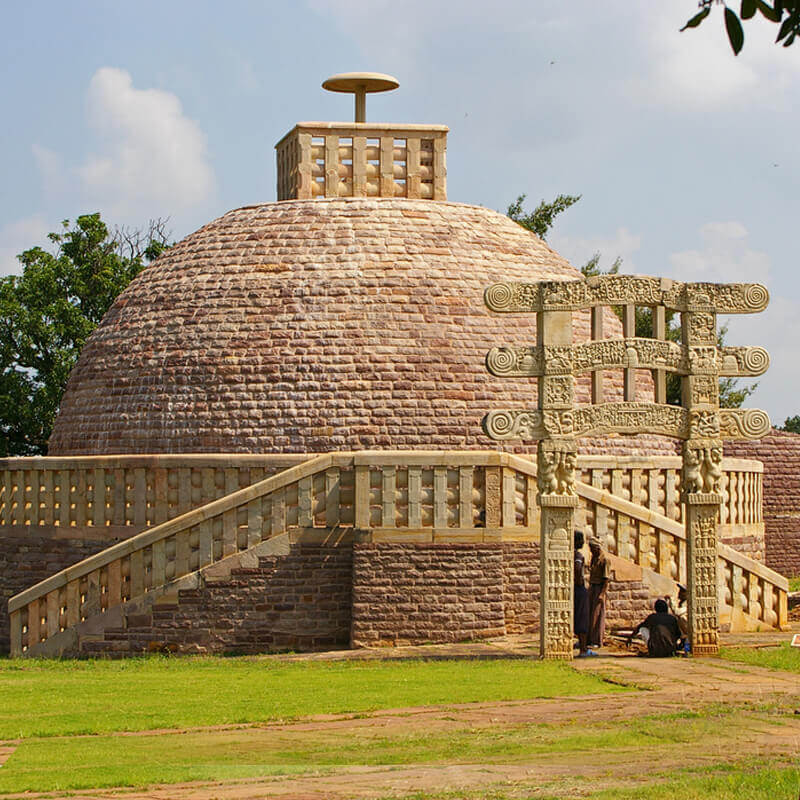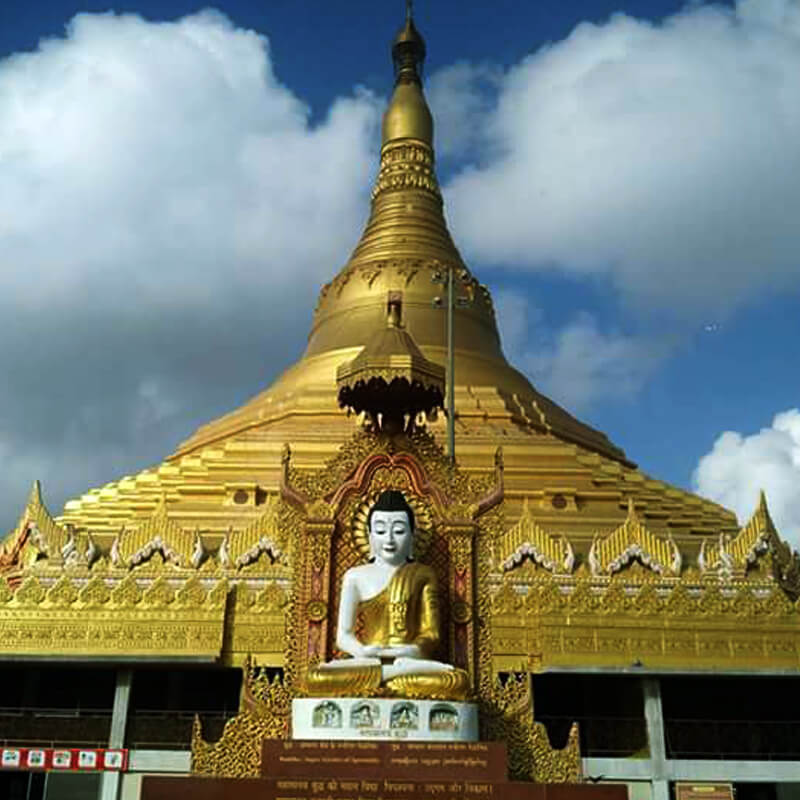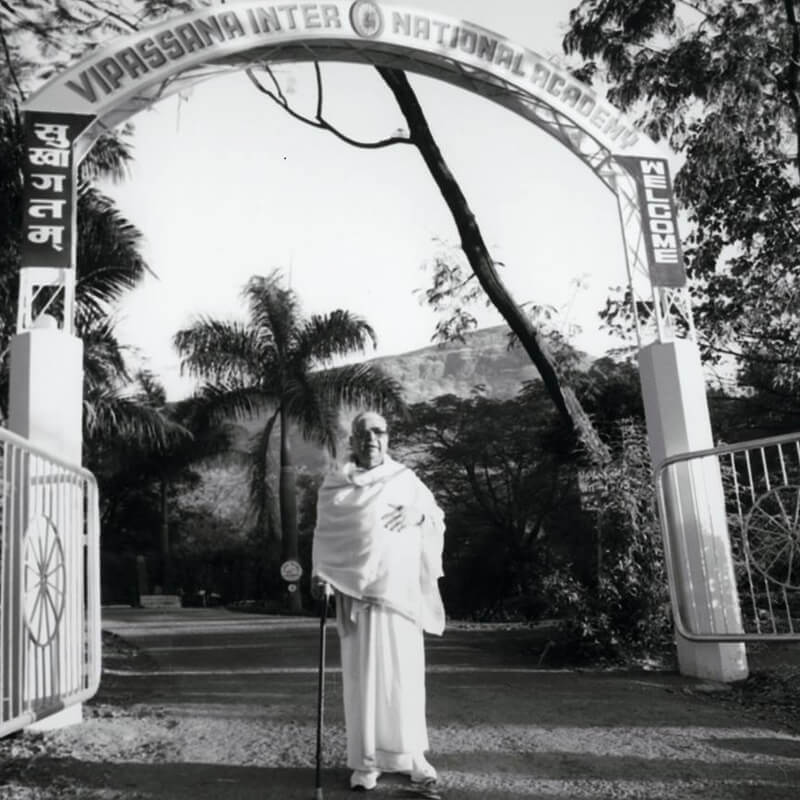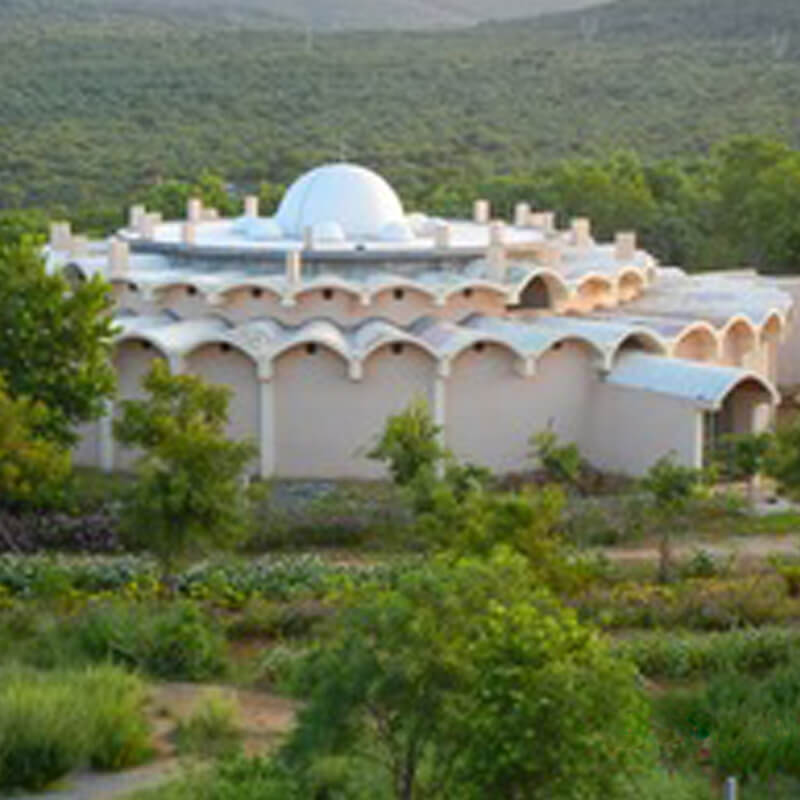
Introduction
The Global Vipassana Pagoda was inaugurated on February 8, 2009, by the President of India, Pratibha Patil in the presence of dignitaries from all over the world.
The Global Vipassana Pagoda is a monument of peace which aims to spread teachings of compassion and non-violence propagated by the Buddha and to promote the practise of Vipassana.
The tall pagoda building rises majestically over the GVF complex, spread over 13 acres of lush greenery, near picturesque Gorai in northwest Mumbai, barely a kilometre from the Arabian Sea. The stone structure, which has approximately 280-feet diameter and is 325 feet tall, has the original bone relics of the Buddha - donated by the Sri Lankan government and the Mahabodhi Society of India enshrined in the dome.
The pagoda, a dream project of Principal Vipassana Teacher, Mr. S.N. Goenka, has been constructed mainly with donations received from former students and devotees around the world. The people of Myanmar donated the marble used for the flooring and the umbrella placed atop the pagoda. The people of Thailand donated the golden paint typically used in pagodas, which is not available in India. In addition, a student's family donated the land while other past students of Vipassana and others contributed around Rs.800 million to construct the entire structure.
Addressing the gathering on the occasion, Goenkaji expressed gratitude towards the country of Myanmar which preseved not only the Words of the Buddha but also the Practice in its purest form for 2 millenia.
One day courses are regularly held at the Pagoda attended by up to 8000 meditators.
The Etymology of the Pagoda
The popular term ‘pagoda’ is neither from Pali or Sanskrit nor from Hindi or any other Indian language. It is not from the Sri Lankan, Myanmar, Thai, Cambodian, Laotian, Chinese or Japanese languages. Let us see how it originated.
The thūpa in which the relics of the Buddha or any arahant is enshrined was called dhātu-gabbha (dhātu=relics, gabbha=interior, cavity, cavern, womb). With the passage of time, all thūpas began to be called dhātu-gabbha. Later this became corrupted todhagabbha or dhagobā or dagobā. A few centuries ago, when Portuguese sailors first came to the east, they did not see anythūpas in India but they saw thūpas in many places in Sri Lanka. They asked the local people and were told that these weredagobā. They found it difficult to pronounce this new word and started to call dagobā as pagodā. Later when they went to other Buddhist nations, they saw many thūpas there which they called pagodā. As time passed, the thūpas that were earlier calledcetiya, cedīgo or thūpa were all called pagodā. Later on, the term pagodā became popular not just among foreigners but also among the local inhabitants.
Design of the Pagoda
When the Buddha sits cross-legged, the width and height of the body are nearly the same.
The Pagoda is a symbol of the Buddha in meditation. The Buddha's body was of golden color, so the pagoda has been colored gold. An extremely delicate soft crown (parasol) is placed atop the Pagoda. Each part of the Pagoda's design has a deeper meaning. From its broad base, the pagoda moves elegantly upward in an increasingly refined way culminating at the top in a single pointed diamond. In the same way, progress on the path of Dhamma is accomplished by the gradual elimination of impurities starting with the gross ones and then removing more and more subtle ones. Thus, the Pagoda symbolizes, the entire path of the Dhamma i.e. morality, concentration & wisdom.
Square Terraces: This broad base of the pagoda signifies suffering, i.e. Dukkha resulting from ignorance, the stage which most of humanity occupies. Moving upward, the square terraces represent the causes of this suffering: craving, aversion and ignorance.
Octagonal Terraces: They represent a person's first steps on the eight-fold noble path i.e. morality and the preliminary understanding of the true nature of the three causes of suffering. Here one begins to appreciate there is a way out of this suffering.
Inverted alms bowl: It signifies renouncing worldly life. The shape of the overturned bowl represents the stage of Dhamma practice where one refuses to create new suffering, i.e. creating new sankhāra. Girdling the inverted alms bowl, are three bands that represent the fundamentals of this path- sīla, samādhi and pañña.
Seven Bands: These seven rings represent the seven stages of purification, satta vissudhi. This section represents seven graduated stages of Vipassana practice culminating in the total purification of mind.
Banana Bud: A banana tree can give fruit only once. This section represents the stage where the meditator has passed through higher stages of development and has reached the point where all saṅkhāra have been burned off.
Lotus Petals: The lotus section is divided into lower lotus and upper lotus. The lower lotus symbolizes one is still capable of creating new sankhāra but in the upper one, this is no longer possible. Thus, the important transition point represented here as a necklace of orbs, is the nibbanic experience, the transcending of mind Like the lotus which flowers in fetid water but sits above it, a Vipassana meditator at this stage remains still tethered to the world but now decidedly apart from it.
Seven-tiered Umbrella and Diamond Bud: The ornamental umbrella pays reverence to this crown of human experience. Atop the entire edifice sits the diamond bud, signifying the ultimate goal of the purification process: the total eradication of all defilements, full enlightenment.
Construction of the Pagoda
Designed by Indian architect Chandubhai Sompura on the lines of the Shwedagon Pagoda in Yangon, Myanmar, the Global Pagoda is a hollow structure, having a dome of 280-ft diameter. Below it is a massive 6,000-sq mt pillar-less meditation hall which can accommodate 8,000 meditators at a time.
In October 1997, the foundation stone of the Global Vipassana Pagoda was laid on the Essel Plateau in Mumbai. In the eleven years since this auspicious event, the construction work progressed without interruption, supported selflessly by Vipassana meditators and devotees from around the world.
Combining ancient building principles with modern techniques of construction, Sompura finally guided a structure using the 'interlocking principle of construction' for the huge stones - each weighing around 600-700 kgs. Unlike cement and steel structures, the use of stone and lime mortar gives it strength and longevity, it ensures that the structure becomes more stable with increased height and weight placed on it as the stones grip each other more rigidly to defy gravity. It is expected to last for more than 2,000 years.
The inter-locking principle: When Goenkaji first expressed his wish to have such a dome built without any pillars in the gigantic Meditation Hall, to avoid inconvenience to meditators, almost all consultants and a number of technical personnel expressed their doubts and said this was almost an impossible task. The high cost was another factor. When the matter came to the notice of a Sompura Consultant, he actually demonstrated the idea of locking system of stones by using bars of soap. He cut the soap into shape the same way the stones here are cut. Each stone in the Global Pagoda has grooves cut both in horizontal and vertical direction, and is so designed that it interlocks in both directions. The entire construction is done using lime mortar to ensue longevity and strength of the structure.
Utmost care has to be exercised for such construction work. Only after each layer is fully completed in a circle, do the individual stones remain secured in their place. The foundation and the base level of the Pagoda are built with black basalt stones. The average depth of the foundation is 30 ft with about 20 ft width. The inner dome and outside serrations are constructed from Jodhpur stone historically known for its longevity and used in many Indian structures.
Approximately 2.5 million tons of stone have been used. These were carted from quarries in Rajasthan, more than a thousand kilometers from the construction site. Its transportation, cutting and fixing in place in itself was mammoth work requiring expertise in man and material handling. For the inner dome alone, approximately 15,500 cubic meters of Jodhpur stones, and 46,000 cubic meters of basalt stones were used.
It has been calculated that this means if we fill trucks with all the stones so far used in the Pagoda, and the trucks are placed one behind the other, the number of trucks in line will stretch from Mumbai to Igatpuri, 120 kms away! This gives us some idea of the logistics involved in bringing such quantity of stones from faraway places as Rajasthan, cutting the stones into shape, and then hoisting them carefully into place. It took a total of 3.87 million man-days to complete this unique monument.
Besides the main pagoda, two small pagodas of 60 ft height have been constructed and one of them contains individual cells for meditators to practice Vipassana. The basement area is 200,000 sq. ft. It contains a basement structure providing accommodation for service facilities, parking area and rest rooms. It will also have display galleries which will provide information on Vipassana and depict the historical truth about the Buddha and inspiring incidents from his life.
Relics of the Buddha
The corporeal relics of the Buddha have been enshrined in the second dome of the Global Vipassana Pagoda in 2006. These relics were donated by the Government of Sri Lanka and the Mahabodhi Society of India, Bodh Gaya.
This is as per the instructions of the Buddha which can be seen in the Sutta Pitaka that his corporeal remains were to be placed in a stupa where people could meditate in its presence. (Source: Nibbana Sutta of the Digha Nikaya which is a part of the Sutta Pitaka of the Pali Tipitaka).
After the Mahaparinibbana Sutta of the Buddha, his corporeal relics were distributed into 12 parts amongst the different kingdoms of North India and stupas were built to house them. Emperor Asoka retrieved all these relics, divided them into smaller parts and enshrined them in 84,000 stupas built across India. The Archaeological Survey of India has started excavating these stupas.
The relics kept in the Pagoda were excavated from Bhattiprolu, Guntur district, Andhra Pradesh, South India. A golden Wheel of Dhamma marks the center of the Dome roof. Directly above this, in the second dome, the corporeal relics of Lord Buddha have been enshrined. The upper two windows of the Pagoda mark the entrance to the 2nd dome of the Pagoda.
Inauguration of the Global Vipassana Pagoda
Goenkaji’s long cherished dream was fulfilled on February 8, 2009 when the President of India, Pratibha Patil, inaugurated the Global Vipassana Pagoda in the presence of thousands of meditators, dignitaries, and guests from all over the world.
Other dignitaries present at the event included the Governor of Maharashtra Mr. S.C. Jamir, Union ministers Mr. Sharad Pawar and Mr. Praful Patel, Deputy Chief Minister of Maharashtra Mr. Chhagan Bhujbal, Mrs. Priyanka Gandhi-Vadra and Mr. Robert Vadra, foreign dignitaries, members of the diplomatic corps in Mumbai and representatives of all religions.
In her keynote address, the President of India emphasized the need to defeat the divisive forces that were using people’s perceived differences to spread antagonism and terrorism. People were creating distinctions in their own minds and believing them to be true. An ideology of hatred was proliferating using the tools of violence and terrorism.
Dedicating the Global Pagoda as a Monument of Peace and Harmony to humanity, Mrs. Pratibha Patil said that Vipassana helps to gain control over the mind, develop purity of heart and live a more balanced life. In a world full of strife and strain, there is a great need for a way to calm the agitated mind. She remarked that she herself had done a ten-day Vipassana course.

(The then President of India, Mrs. Pratibha Patil, greets Goenkaji at the inauguration ceremony.)
Goenkaji then gave a discourse in which he stressed that the Buddha was not the founder of a religion but a super-scientist. The Buddha’s teaching is not limited to the members of any one religion but are for the benefit of all people. The essence of his teaching is Vipassana, which is a simple and scientific way to develop peace and harmony for oneself and others.
A day earlier, on February 7, 2009, in the presence of Goenkaji, Mataji and thousands of Vipassana meditators and guests, the Dhamma dhaja (flag of Dhamma) and crystal were mounted at the top of the Global Pagoda. This was followed by sangha-dāna for venerable bhikkhus from Myanmar, Thailand, Sri Lanka and India.
The 325 feet tall Global Vipassana Pagoda is a symbol of gratitude towards the Buddha and the chain of teachers who preserved it for 2600 years. The bone relics of the Buddha donated by the government of Sri Lanka and the Mahabodhi Society of India were enshrined securely in this pagoda on top of the dome above the Dhamma Wheel on October 29, 2006.
The Global Pagoda is located near Gorai in northwest Mumbai. It is a replica of the Shwe Dagon in Yangon, Myanmar. However, unlike the Shwe Dagon, the Global Pagoda is a hollow structure and the dome encloses a meditation hall in which about 10,000 meditators can meditate together at a time. A few one-day Vipassana courses have already been conducted in this hall.
The Global Vipassana Pagoda complex also has the Vipassana centre, Dhamma Pattana, where ten-day and old-student courses are being conducted regularly since October 2007.
The Global Vipassana Pagoda is flanked by two smaller pagodas, each 60 feet high. Construction of one is complete and work on the other which will house meditation cells will begin soon. The Pagoda complex will also house libraries and information galleries displaying numerous paintings depicting the life and teaching of the Buddha.
The Pagoda was opened to the public after the official inauguration. The grandeur and architectural style of the Global Pagoda, the enshrined Buddha relics and the information galleries are expected to attract thousands of pilgrims and seekers of peace.
(The recording of the webcast of the inauguration function can be viewed on the Global Pagoda website:www.globalpagoda.org/webcast.html)

(A close-up of the very top of the Global Vipassana Pagoda)
The natural rock crystal is over two feet long and has been carved in the shape of a lotus bud.
Website for the Global Vipassana Pagoda
Following website contains detailed information, photos and other updates of the Global Vipassana Pagoda
http://www.globalpagoda.org/
Documentary on the Global Vipassana Pagoda
It is a documentary showcasing the history of Vipassana and concentrates on the early years of the construction of the Global Vipassana Pagoda until mid-2006. It details how the structure was built and how the novel construction method of masonry was used instead of concrete.






